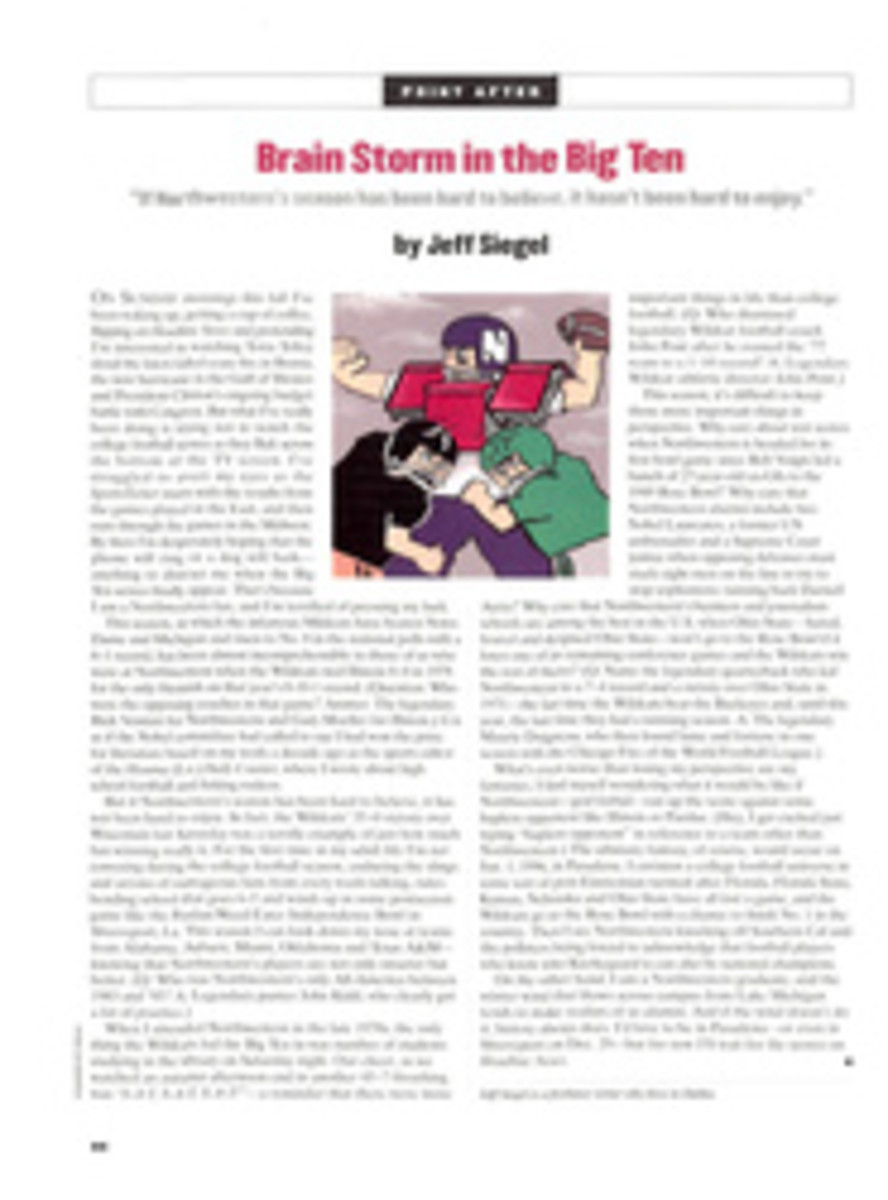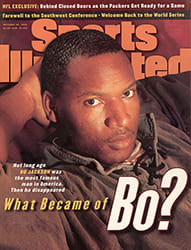
WOODSTOCK ON WHEELS EVERY SUMMER THOUSANDS OF CYCLISTS REVEL IN RIDING EN MASSE ACROSS IOWA
IN 1973, Des Moines Register copy editor John Karras and
columnist Donald Kaul conspired to escape the newsroom and meet
real Iowans out on the farms by biking across the state. They
invited readers to join them. To their surprise, more than 200
turned up at the designated rendezvous, a Sioux City motel.
What began as a lark has evolved into a boisterous Iowa
institution. The Register's Annual Great Bicycle Ride Across
Iowa (RAGBRAI) has traversed the state every July for 23
years--always eastward from the Missouri River to the
Mississippi in seven days, but by different routes and
accompanied by proliferating hordes. "We didn't invent this, we
discovered it," Kaul says. "People always wanted this kind of
adventure. It's the highlight of their year."
At least a dozen states have organized copycat tours, but none
of them matches the RAGBRAI in size or gusto. Imagine a
Woodstock on wheels, a marathon crossed with a Mardi Gras. "The
RAGBRAI is like the Grand Canyon," says Karras, now semiretired
from the paper. "You can't envision it until you get there."
Nothing could have prepared me for what I found in the border
town of Onawa, this year's launch point. On the eve of the race,
the fourth Saturday in July, a honking caravan of Winnebagos,
U-Hauls and schoolbuses outfitted with rooftop decks converged
in merry gridlock. RAGBRAI's mass of 14,000 cyclists subdivides
itself into clubs, charter groups and various other tribal
cliques distinguished from one another by uniforms and logos.
Here they came: Team Widebody, Team Tushosaurus, Team Wimpy,
Team Whiners, Team Crotchety, Team Cucumber, Team Gumby, Team
Cockroach, Team Barfly, Team Horny, Wisconsin's Dairy-Aires, the
Flying Monkeys and the Killer Bees, among others. "It's like a
big family reunion," Kevin Voysey of Two Rivers, Wis., said
after dipping his rear wheel into the Missouri, the inaugural
ritual of each year's ride. "Nobody is a doctor or lawyer.
Barriers just drop. For seven days, it's just RAGBRAI."
Within hours the cyclists and support crew outnumbered the
population of quiet little Onawa (birthplace of the Eskimo Pie)
nearly four to one. An enclave of tents and booths had sprung
up. There, riders drank beer, got massages, bought T-shirts,
consulted repairmen, ate dinner, read the Register's front-page
coverage of the event, checked the forecast and, more often than
not, downed more beer. The tent city covered so much acreage
that friends communicated by posting notes on a message board
made of eight sheets of plywood.
I began Sunday's 70-mile trip to Lake View before dawn, pedaling
down Onawa's main street, Iowa Avenue, amid a seemingly endless
procession of cyclists riding three or four abreast. Soon we
were surrounded by cornfields and weathered barns.
RAGBRAI is so vast, one rider would later tell me, that he lost
his best friend for the whole week. Fortunately it is also oddly
intimate. Strangers fall into uninhibited conversation. Bikers
buddy-up for an afternoon. Some riders wear T-shirts listing
topics of discussion.
"This town is quiet," somebody said as we coasted into Mapleton,
the first organized rest stop on day one. "They must have been
partying last night."
"This town is always quiet," a man in overalls called from a
sidewalk.
In fact, Mapleton was poised to host more people than it had on
any other day in history. A sea of Lycra and helmets swelled as
riders milled about, refilling water bottles, sipping coffee and
waiting to use portable toilets. Bikes were strewn everywhere.
An old woman played a battered piano that had been carried
outside for the occasion. The migration would continue for hours.
Beyond Mapleton the flat expanse of cornfields gave way to the
Loess Hills. IS ANYBODY WALKING YET? read a sign posted near the
brow of a long slope. THE HILLS GET MUCH WORSE AFTER DANBURY,
another said. "Anyone who came here thinking Iowa is flat is
going home with a different view," said Phil Wirsing of
Rochester, N.Y.
No one was happier to reach Lake View, the first night's stop,
than Marty McDougall and Beth Wilson. They had planned to marry
at 4 p.m. on a stone pier jutting into Blackhawk Lake, but they
lingered too long in Wall Lake, the previous town. They pedaled
to the altar about a half hour late, dismounted and exchanged
vows wearing black cycling shorts and T-shirts, then spent the
night in a tent.
They weren't the only ones pedaling with a sense of occasion.
Heidi Soliday, a sportscaster for KCCI-TV in Des Moines, started
the ride although she was more than eight months pregnant. "It
was my eighth straight RAGBRAI," Soliday said after finishing.
"I wasn't going to let a little thing like pregnancy interfere."
She reluctantly agreed to take it easy this time; she rode only
on selected days, and she carried a cellular phone just in case.
The rides were long but never dull. For one thing, a particular
humor attends RAGBRAI. This year's joke: Tom Hanks is making a
movie about RAGBRAI. It's going to be called Sorest Rump.
Halfway through Tuesday's 75-mile ride to Iowa Falls, I was
passed by a bearded man wearing a red-striped dress. Ed Gelles
of Knoxville, Iowa, rolled along on a 1941 bike equipped with a
single gear. A sign on it said GEARS ARE FOR WIMPS. Logan Hottle
of Philadelphia covered all 500 miles with her cairn terrier,
Shelby, in her front basket.
It's hard to get bored when you stop for sustenance every five
miles. The RAGBRAI is said to be the only 500-mile bike trip on
which participants often gain 10 pounds. I began each day at the
all-you-can-eat pancake breakfast for 2,000, served under a
tent. The rest of the day was a movable feast. Every farm sold
lemonade; every town offered bratwurst and beer.
The most ardent eater of all was Mark (Dr. Pie) Hilton, a De
Witt, Iowa, veterinarian and the official RAGBRAI pie judge.
Traveling with his own six-member Team Pie ("pedalin' for a
piece" was its motto), Hilton sampled 20 or so slices along the
route and graded them on a scale from zero to 100. This year's
winner: a pecan-and-coconut concoction called "sawdust pie,"
which was baked by Elaine Wardenburg, a co-owner of Emma's Tea
Room in Williamsburg. Hilton declared it the best he had tasted
in five years of judging.
Gluttony is excusable when you're covering great distances. On
the fourth day road-toughened legs propelled us 98 miles (with
an optional spur for those who wished to surpass 100). But the
triumphant day ended on a sad note: one of RAGBRAI's old guard,
81-year-old Madeleo Blake, died of a heart attack that night in
his camper after cycling the optional miles and eating a
generous dinner. It was his 20th RAGBRAI. "This is the way he
would have chosen to go," said his wife, Ileane.
The next day we biked 75 miles into southeast Iowa--a modest
distance that turned difficult when a 30-mph headwind stirred
cornfields into violent motion. We fought for every yard, even
downhill. I felt as if I were dragging a manhole cover.
A touch of sunstroke had made me loopy by the time I reached
Keswick, so I ducked into the American Legion hall for a slice
of rhubarb pie. A cyclist lifted her head from the table and
vowed she would give her bike away rather than face the day's 10
remaining miles. She was not alone. Three thousand bikers gave
up and rode to Sigourney in vans known as sag wagons. By the
time I dragged into Sigourney that afternoon, the massage tent
looked like a M*A*S*H* unit. Some had dubbed the day Terrible
Thursday, others 4-H Day, for heat, humidity, hills and head-wind.
After a glorious 60-mile ride expedited by merciful tailwinds on
Friday, we faced on Saturday a 48-mile sprint to the finish in
the town of Muscatine, a onetime home of Mark Twain. In West
Branch I ate my last stack of pancakes, outside the cottage
where Herbert Hoover was born. "This is a downer of a day," Pete
Nicolai of Sioux Falls, S.Dak., said as we paused in West
Liberty, the penultimate town. "In a few miles the rush to
exchange addresses will begin. Twenty-four hours from now we'll
all be missing RAGBRAI."
The last miles passed in a run to the Mississippi. After
crossing a verdant floodplain we entered Muscatine. People stood
on their lawns and applauded. Kids turned sprinklers toward the
street and handed us cups of water.
At last the river came into view at the foot of Mulberry Avenue.
Teams clustered into tight convoys so as to arrive together.
Police waved us past barricades and over railroad tracks to a
landing where we dipped our front tires into the river, which is
RAGBRAI's concluding rite. A few feet from the dipping station
stood a wreath in memory of Madeleo Blake. A friend rode Blake's
red bike to Muscatine and dipped it for him. The bike was later
parked beside Blake's casket in a Columbus Junction funeral home.
For a moment I imagined our momentum carrying us inexorably
eastward. But of course, it didn't. The group's energy
dissipated in the muggy riverside heat. Cyclers drifted away to
pack their buses and drove off. RAGBRAI dispersed, or maybe just
adjourned. "I won't want to touch my bike again for months,"
said Joe Karaskevicus of Mantua, N.J., "but 'long about April
I'll start feeling the RAGBRAI itch again."
This is New York-based freelance writer Michael Cannell's fourth
story for Sports Illustrated.
COLOR PHOTO: DAVID WALBERG Before the ride-launching rite of dipping their rear wheels in the Missouri River, cyclists made camp wherever they could in Onawa. [Cyclists]
COLOR PHOTO: DAVID WALBERG [See caption above--Tents at cyclists camp]
COLOR PHOTO: BUCK MILLER At sunrise on the seventh day, the riders rolled through West Branch. [Cyclists]

